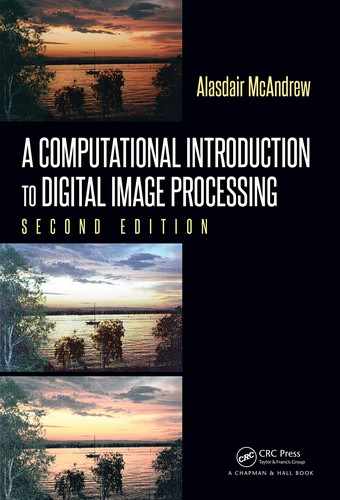xiv
Chapter 13 contains a new section at the end introducing one version of the retinex algo-
rithm. Chapter 14 implements a simpler and faster method for run-length encoding, and
includes a new section on LZW compression. Chapter 15 has been simplified, and more
connections made between the discrete wavelet transform and digital filtering. Also in this
chapter a new wavelet toolbox is used, one that amazingly has been written to be used
in each of MATLAB, Octave, and Python. In Chapter 16 the greater modularity of the
programs has allowed a greater conciseness, with (I hope) increased clarity.
Finally, new images have been used to ameliorate licensing or copyright difficulties. All
images in this book are either used with permission of their owners, or are the author’s and
may be used freely and without permission. They are listed at the end.
Acknowledgments
The first edition of this book began as set of notes written to accompany an undergrad-
uate introductory course to image processing; these notes were then extended for a further
course. Thanks must go to the many students who have taken these courses, and who have
discussed the subject material and its presentation with me.
I would like to thank my colleagues at Victoria University for many stimulating conver-
sations about teaching and learning. I would also like to thank Associate Professor Robyn
Pierce at the University of Melbourne, for providing me with a very pleasant environment
for six months, during which much of the initial programming and drafting of this new
edition was done.
Sunil Nair and Sarfraz Khan, of Taylor and Francis Publishing Company, have pro-
vided invaluable help and expert advice, as well as answering all my emails with admirable
promptness. Their helping hands when needed have made this redrafting and rewriting a
very pleasant and enjoyable task.
I am indebted to the constant hard work of David Miguel Susano Pinto (maintainer of
the Octave Forge image package under the alias of Carnë Draug), and his predecessor Søren
Hauberg, the original author of the image package; also Stefan van der Walt, lead developer
of the Python scikit-image package. They have made lasting and valuable contributions to
open-source imaging software, and also have answered many of my questions.
I would also like to thank the reviewers for their close and careful reading of the initial
proposal, and for their thoughtf ul, detailed, and constructive comments.
Finally, heartfelt thanks to my long suffering wife Felicity, and my children Angus,
Edward, Fenella, William, and Finlay, who have put up, for far too long, with absent-
mindedness, tables and benches covered with scraps of papers, laptops, and books, and a
husband and father who was more concentrated on his writing than their needs.
xv
A Note on the Images
Some of the images used in this book are the author’s and may be used freely and
without restriction. They are:
arch.png
backyard.png
blocks.png
bot
_
gardens.png
buffalo.png
car.png
cat.png
chickens.png
circles.png
circles2.png
color
_
sunset.png
emu.png
engineer.png
handmade.png
iris.png
koala.png
meet
_
text.png
monkey.png
morph
_
text.png
newborn.png
nicework.png
paperclips.png
pelicans.png
pinenuts.png
rings.png
seagull.png
stairs.png
street.png
sunset.png
twins.png
venice.png
wombats.png
MIT Press has kindly allowed the use of the standard test image
cameraman.png
The following images have been provided courtesy of shutterstock.com:
blood.png
paramecium.png
The image
caribou.tif
has been cropped from the NOAA image anim0614.jpg, a photograph of a caribou (Rangifer
tarandus) by Capt. Budd Christman of the NOAA Corps.
xvi
The image
monastery.png
has been taken from http://www.public-domain-image.com; more particularly from
http://bit.ly/18V2Z57
: the photographer is Andrew McMillan.
The image
daisies.png
has been taken from
www.pixabay.com
as an image in the public domain; the photographer
is Marianne Langenbach.
The iconic image
thylacine.png
showing the last known living thylacine, or Tasmanian tiger, at the Hobart zoo in 1933, is
now in the public domain.
The x-ray image
xray.png
has been taken from Wikimedia Commons, as an image in the public domain. It can be
found at
http://bit.ly/1Az0Tzk; the original image has been provided by Diego Grez
from Santa Cruz, Chile.
MATLAB and Simulink are registered trademarks of The Mathworks, Inc. For product
information, please contact:
The Mathworks, Inc.
3 Apple Hill Drive
Natick, MA 01760-2098 USA
Tel: 508-647-7000
Fax: 508-647-7001
Email:
Web: www.mathworks.com
..................Content has been hidden....................
You can't read the all page of ebook, please click here login for view all page.
